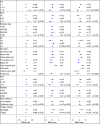Impact of straw return on greenhouse gas emissions from maize fields in China: meta-analysis
- PMID: 40078633
- PMCID: PMC11897293
- DOI: 10.3389/fpls.2025.1493357
Impact of straw return on greenhouse gas emissions from maize fields in China: meta-analysis
Abstract
Introduction: An increase in the amount of greenhouse gases (GHGs) in the atmosphere causes global warming, and >14% of all GHG emissions come from agricultural activities. The three primary atmospheric GHGs are CO2, CH4, and N2O; therefore, regulating GHG emissions from agroecosystems is important for global climate management. Straw return is an environmentally friendly agricultural practice that positively affects crop production and soil fertility. However, its effects on long-term GHG emissions remain controversial.
Methods: To examine the impact of straw return on GHG emissions from Chinese maize fields, 281 data pairs from 45 publications were assessed using a data meta-analysis.
Results: The findings demonstrated substantial increases in CO2 and N2O emissions of 140 and 40%, respectively. Methane emissions increased by 3% after straw return, and the maximum effect value of CO2 emissions was 2.66 at nitrogen rates<150 kg/hm2. The effect value of CH4 emissions increased with an decrease in soil organic content, and the effect value of CH4 emissions changed from negative to positive at concentrations >6 g/kg. With a nitrogen rate increase, N2O emission effects under straw return initially increased and then decreased. N2O emissions increased significantly when nitrogen rates were<250 kg/hm2. The results of a random forest model showed that the most important factor affecting CO2 and N2O emissions from corn fields under straw return was the amount of nitrogen applied, and the most important factor affecting CH4 emissions from corn fields under straw return was soil organic carbon content.
Discussion: This shows that a suitable straw return can achieve the mutually beneficial goal of guaranteeing food security and minimizing adverse effects on the environment.
Keywords: greenhouse gases; maize; meta-analysis; random forest; straw return.
Copyright © 2025 Sun, Gu, Wang, Gao, Wang, Chen and Sun.
Conflict of interest statement
The authors declare that the research was conducted in the absence of any commercial or financial relationships that could be construed as a potential conflict of interest.
Figures






Similar articles
-
Meta-analysis of GHG emissions stimulated by crop residue return in paddy fields: Strategies for mitigation.J Environ Manage. 2024 Nov;370:122519. doi: 10.1016/j.jenvman.2024.122519. Epub 2024 Sep 26. J Environ Manage. 2024. PMID: 39332291
-
Net mitigation potential of straw return to Chinese cropland: estimation with a full greenhouse gas budget model.Ecol Appl. 2010 Apr;20(3):634-47. doi: 10.1890/08-2031.1. Ecol Appl. 2010. PMID: 20437953
-
Effects of straw mulching and nitrogen application rates on crop yields, fertilizer use efficiency, and greenhouse gas emissions of summer maize.Sci Total Environ. 2022 Nov 15;847:157681. doi: 10.1016/j.scitotenv.2022.157681. Epub 2022 Jul 28. Sci Total Environ. 2022. PMID: 35908708
-
Does biochar accelerate the mitigation of greenhouse gaseous emissions from agricultural soil? - A global meta-analysis.Environ Res. 2021 Nov;202:111789. doi: 10.1016/j.envres.2021.111789. Epub 2021 Jul 29. Environ Res. 2021. PMID: 34333013 Review.
-
Patterns and environmental drivers of greenhouse gas fluxes in the coastal wetlands of China: A systematic review and synthesis.Environ Res. 2020 Jul;186:109576. doi: 10.1016/j.envres.2020.109576. Epub 2020 Apr 25. Environ Res. 2020. PMID: 32361080
References
-
- Ali M., Muhammad S., Zakir K. A. I. A. (2019). The use of crop residues for biofuel production. Biomass Biopolymer-Based Mater. Bioener. 16, 369–395. doi: 10.1016/B978-0-08-102426-3.00016-3 - DOI
-
- Ben-Noah I., Friedman S. P. (2018). Review and evaluation of root respiration and of natural and agricultural processes of soil aeration. Vadose Zone J. 17, 1–47. doi: 10.2136/vzj2017.06.0119 - DOI
-
- Bhattacharyya P., Bisen J., Bhaduri D., Priyadarsini S., Munda S., Chakraborti M., et al. . (2021). Turn the wheel from waste to wealth: economic and environmental gain of sustainable rice straw management practices over field burning in reference to India. Sci. Total Environ. 775, 145896. doi: 10.1016/j.scitotenv.2021.145896 - DOI
-
- Chan K. Y., Heenan D. P., Oates A. (2002). Soil carbon fractions and relationship to soil quality under different tillage and stubble management. Soil Tillage Res. 63, 133–139. doi: 10.1016/S0167-1987(01)00239-2 - DOI
Publication types
LinkOut - more resources
Full Text Sources

